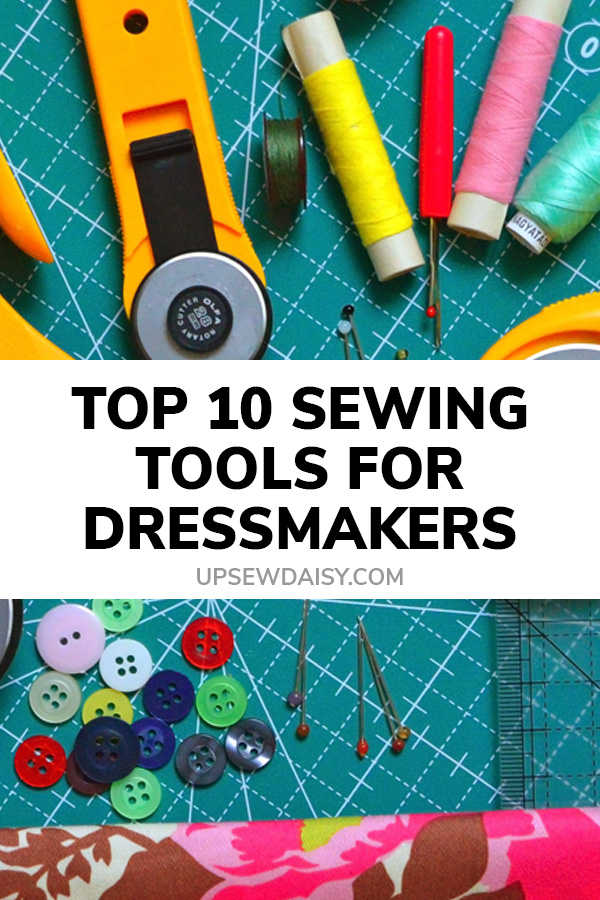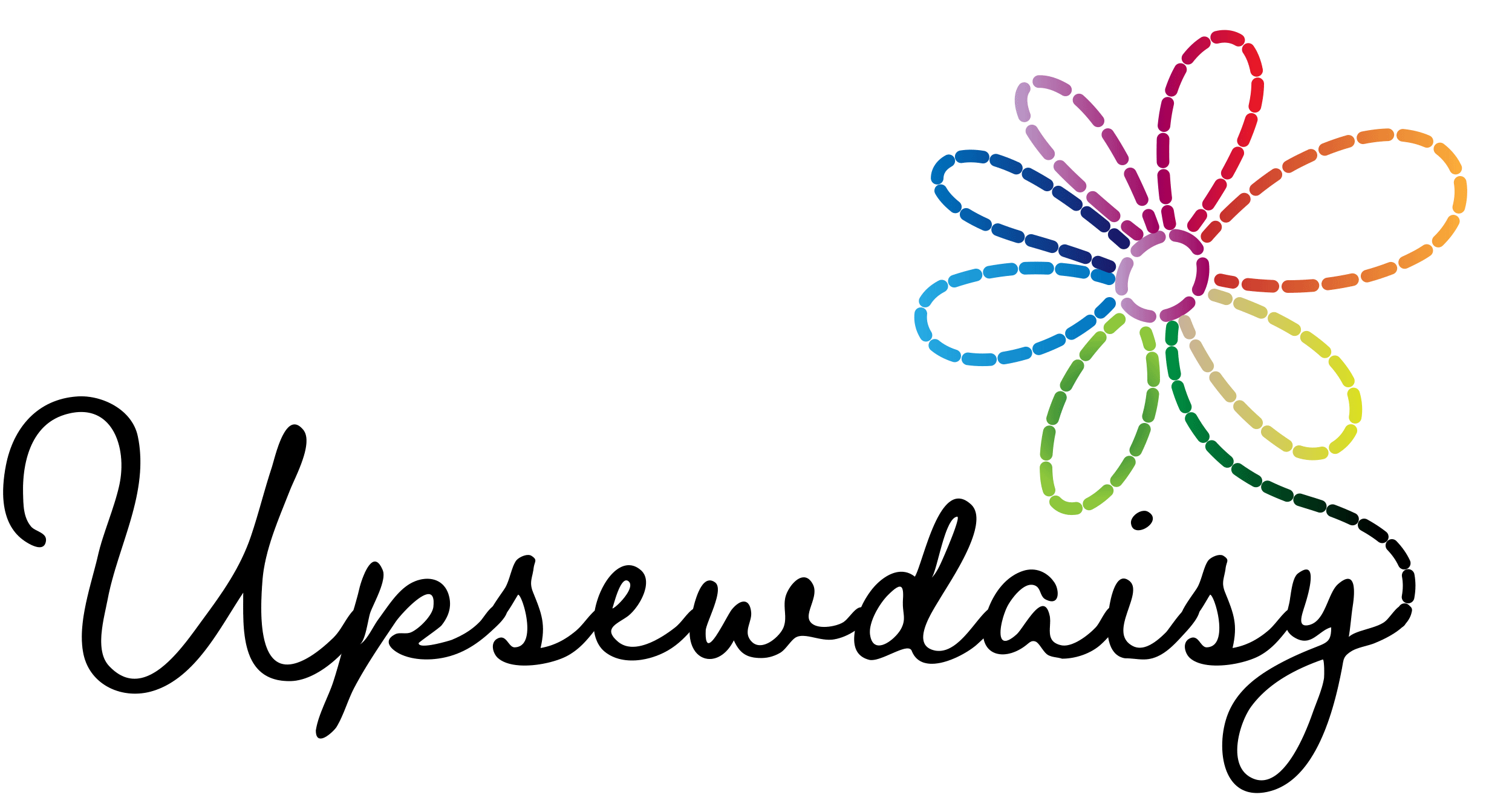Once I got serious about sewing my own clothes I started to feel I could justify a few more tools to make the whole process faster and easier. Here are the tools I added to my beginners tool collection.
1. 45mm Rotary Cutter and Self-healing Cutting Mat
Don’t get me wrong, I still use my scissors all the time but nothing beats a rotary cutter for speed and accuracy. I use it for anything that will fit on my cutting mat. I was recommended the KAI rotary cutter by another sewist and I love it but the Olfa brand* is also often highly recommended. I also have this 28mm cutter from Hobbycraft which I use for smaller pattern pieces like bras. It’s not as comfortable to use as the KAI but it does the job! It took me a long time to find the perfect cutting mat as I wanted a large self healing mat that measured in inches and had no chemical smell. My Sullivans Cutting Mat* is made from non-toxic Low Density Polyethylene (LDPE) and it’s brilliant. Absolutely no smell, still going strong after months of regular use and it hasn’t warped or needed cleaning once.
2. Walking or Even Feed Foot
When I first got my even feed foot for my Janome* I wanted to marry it I loved it so much! I originally purchased it to help me sew knits but it has really come into its own with napped fabrics like fleece, velvet and velour. Basically, a walking foot is a sewing machine foot that evenly feeds the layers of fabric through the machine as you sew. The foot grips onto the top layer of fabric and helps move it under the needle at the same pace that your machine’s feed dogs are moving the bottom layer of fabric. It’s a bit noisy to use but I have been able to sew knit hems without Wonder Tape since I started using mine. I highly recommend getting an open toe model that fits your machine as it’s much easier to see what you’re sewing.
3. Quilting Rulers
Even if you aren’t planning on doing any quilting, quilting rulers are fantastic for cutting straight lines and square corners. I use mine to cut accurate strips of fabric for neck bands and cuffs. I have both a 6″x24″ and 6″ square ruler. Both of my rulers are in imperial measurements because I found most of the patterns I was using were in inches. I also regularly use my standard school ruler for quick measurements and a metre ruler for long, straight cuts and lining up grain lines across fabric on my cutting mat.
4. French Curve
Once you decide to sew your own clothes you will inevitably need to make pattern alterations at some point. A French curve* is perfect when redrawing armscyes, blending between sizes and of course drafting your own patterns. It’s also great for adding seam allowances if you’re brave enough to take on a pattern without them!
5. Pinking Shears
Pinking shears look like regular scissors but instead of flat blades there are little triangle “teeth” on the blades that make zigzag cuts in the fabric. They are used to finish the raw edges of the fabric and prevent fraying and I use them for “clipping the curves” under facings and for preparing woven fabric before washing. They work best on woven fabrics although some silks and thinner fabrics can bunch up and not give you a clean cut. I actually got my pinking shears from Aldi and are very happy with them.
6. Wonder Clips
Wonder clips are fantastic if, like me, you’re sick of poking yourself with pins or terrified of the thought of running over one with your overlocker. They’re also great for securing fabric that you don’t want to leave holes in, for bulky layers too thick for pins and when you’re applying binding. If you’re wondering whether you should shell out for the very expensive branded wonder clips or just get some cheap copies from Amazon*, wonder no more. I can confidently say the cheap copies are basically as good as the real deal. Sure, they’re sometimes a little stiffer to open but I haven’t noticed any real difference in quality between the two and my set is still going strong with no breakages so far.
7. Tailor’s Ham
A tailor’s ham is a little cushion that you can use when pressing curved seams such as at the bust, hip, sleeve heads and collar. You can buy a pretty one* but you can also easily make your own! Try this great tutorial from Kristiann Boos from Victory Patterns. Using a tailor’s ham takes the professional finish of your garments to a whole new level.
8. Sewing Gauge
I use my Hemline sewing gauge* every time I hem a garment and also for button holes, pleats and even for checking the tension of knitting! Such a great tool for such a small amount of money.
9. Bias Tape Maker
I often buy pre-made bias tape but when I do take the time to make my own my Clover bias tape maker* is brilliant. I’ve used it to create binding for my needle organiser and for making self fabric ties for a linen dress, cotton coverup and even a bamboo knit jumpsuit. If you follow the instructions (and maybe a YouTube video or two) it really is easy and then you can have matching binding for everything you make!
10. Overlocker
Yes, I’m going to say it. I sewed my own clothes for over a year before buying one but you can’t beat the professional finish and incredible amount of time saved by using an overlocker. I took a really, really, REALLY long time to decide on which overlocker to get but definitely haven’t regretted my decision. I recommend asking around, researching online and finding a local dealer you trust to give you their advice. I went to Franklins in Salisbury after many positive reviews and the service I had was brilliant. I ended up buying a different overlocker to my planned purchase due to their expertise and I’m glad I did. I chose the Juki MO-654DE in the end because I didn’t want to buy a lesser powered, cheaper model I would need to upgrade in a year.

*Affiliate links: if you click through and make a purchase I may get a commission (at no additional cost to you). Visit my disclaimer page for more info.
